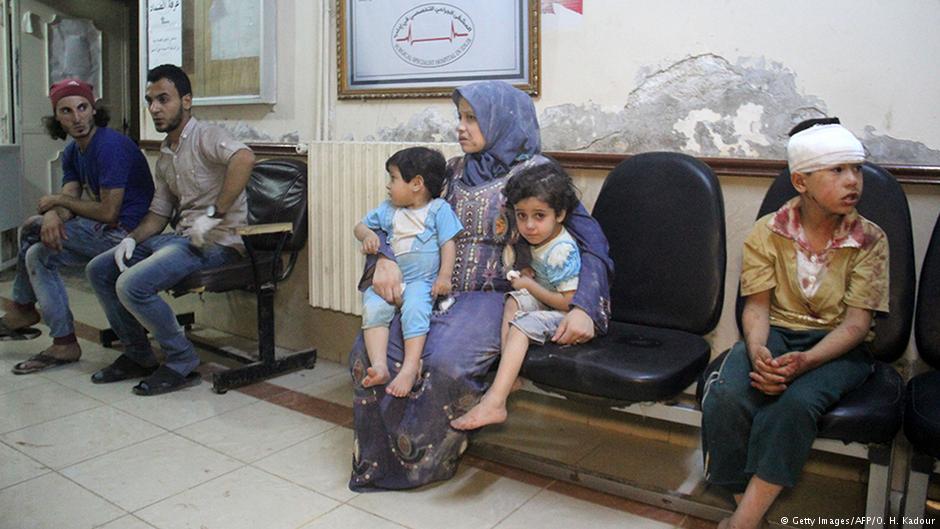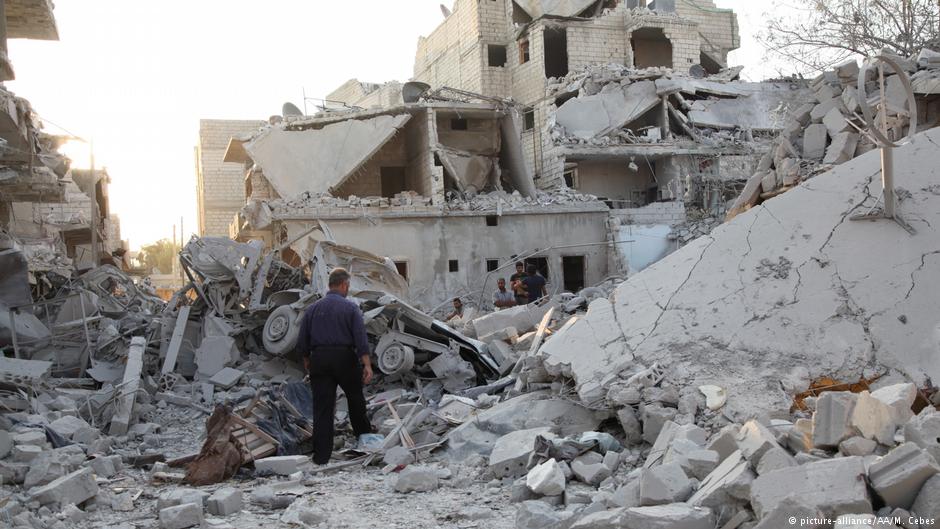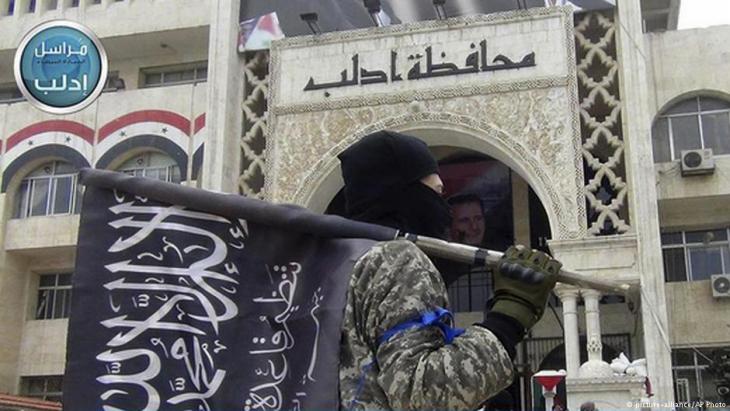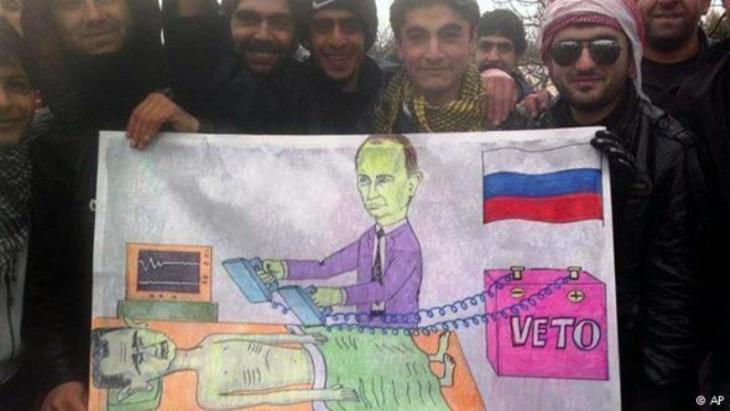Fighting the jihadists with unusual weapons

They started out as a health authority on wheels. In 2013, Dr Munzer Khalil and two colleagues began driving around the province of Idlib in an ambulance. An office would have been too dangerous, says Khalil, head of the health authority, at a conference of the Union of Medical Care and Relief Organisations (UOSSM) in Berlin. After all, he adds, the regime of President Assad carries out targeted bombing raids on medical facilities in order to destroy health provision in opposition areas. The situation hasn't changed.
According to UNICEF, many of the 107 hospitals and clinics attacked during the first half of 2017 are located in the North-West of the country. In addition, the Hama Central Hospital, which specialised in surgical emergencies, had to close following a rocket attack on 26 September and the Al-Tah maternity clinic near Maarat al-Numan lost its neonatal care unit to bombs on 19 September.
Despite all this, the Idlib health authority has grown into a successful department. Since the withdrawal of Assad's troops from the entire province in 2015, Dr Khalil and his team have been looking after three million residents, among them 800,000 internal refugees who were displaced from other regions by the regime. With 48 hospitals, 533 doctors and 1,275 nurses, the health authority is the largest civilian organisation in north-western Syria.
The authority has only been able to flourish in this manner due to the support of the UOSSM. The NGO, which was founded by Syrian doctors abroad in 2012, maintains good contacts both within Syria and abroad, and is viewed as effective and credible. This means the medics are particularly favoured by foreign donors who want to give humanitarian help to Syria without bolstering the regime or indirectly financing radical fighters. The German government is also supporting the UOSSM to the tune of €8 million.
Financial support under threat
But there is a danger that the money for Idlib could dry up: large areas of the largest of the four deescalation zones set down by Russia, Iran and Turkey, are controlled by the extremist Hayat Tahrir al-Sham (HTS) alliance, founded in January 2017 by various Islamist militias in northern Syria.
The strongest faction is the former Nusra Front. For this reason, the area is increasingly viewed from a western perspective as a "terror province", and no longer as an opposition-held territory worthy of support. The people in the North-West fear that like the inhabitants of former IS-held regions, they will end their lives in the hail of bombs dropped by the international community. Nevertheless, Idlib currently shows that consolidating civil structures is an effective weapon in the battle against terror.

It is indeed the case that the province is dominated by HTS primarily from a military perspective. Other rebel groups, such as the previously powerful Ahrar al-Sham, have either joined the alliance or been significantly weakened. But even the jihadists are aware that a region cannot be governed with weapons alone. What they need is the support of the people. The people of Idlib have always been impoverished and conservative, and after six years of war, three quarters of the population rely on humanitarian aid. So their support will be gained by those who distribute food and medicine, supply electricity and water, look after the people and keep them safe.
Just like Islamic State (IS), HTS is therefore focussing on building up structures. It set up the "civil administration for public services" to monitor and replace existing local councils or civil-society organisations.
But the HTS approach is less brutal that that of IS: instead of taking over institutions by force and publicly executing political opponents, HTS uses intimidation and infiltration. But a study by the Syrian sociologist Haid Haid for the initiative Adopt a Revolution, shows that this doesn't always work.
Haid, who is a researcher at King's College in London, examined the ways in which civil society in northern Syria is fighting extremism. He found out that places with well-functioning local government, reliable public services and close links between civil society and administration are most effective at warding off the influence of the jihadists."No place for al-Qaida in Syria"
In Maarat al-Numan in 2016, for example, residents protested for more than 100 days against an HTS-precursor militia; in February 2017, they took to the streets chanting "No place for al-Qaida in Syria". There are regular protests in other places too, above all when the jihadists attack institutions.
In Atareb, HTS wanted to gain control of the police headquarters, the courts and the administration. The alliance also offered to take over the insolvent local bakery. Broad social resistance, which involved local rebel commanders, dignitaries and elders, succeeded in heading off the takeover. Activists drummed up donations to save the bakery.
Sometimes, civil resistance also demands compromise. In Kafranbel, famous since the beginning of the revolution for its political caricatures, the Nusra-Front stormed the radio broadcaster Fresh FM in January 2016. It confiscated equipment and temporarily detained the manager of the station. The reason it gave for this course of action was that the broadcasting of music is "haram" (forbidden). Radio Fresh FM went on broadcasting. Now, however, activists broadcast animal noises instead of music in between the commentaries.

"We've learned from the mistakes of the past," says Mustafa, a freelance trainer working in the peace sector, in Haid's study. Putting up resistance to Assad and IS has been a kind of "training on the job" and has prepared them for the confrontation with HTS.
Demonstrations are organised via closed groups in social networks or messaging services such as WhatsApp. Ideally, the initiators cannot be clearly identified and are therefore protected from persecution. Although most of the protests are still directed against the regime, demonstrations for freedom and human rights in Idlib also show the jihadists that they cannot control the local people.
In actual fact, HTS does allow most of the demonstrations to go ahead in order to avoid a direct confrontation with local residents. Human rights trainer Kareem is quoted as saying that HTS knows that clashes with the population cannot be won by military means. Haid says this makes it all the more important to mobilise people by creating a long-term political awareness, allaying their fears, calling on them to show unity, and recruiting them to civil institutions.Humour as a powerful weapon
In this endeavour, satire and graffiti are just as important as democratic participation. Activists add their own sarcastic comments to HTS propaganda videos and ridicule the jihadists in caricatures and texts. Humour is a powerful weapon, says activist Fares, who heads up an initiative to strengthen local institutions, adding "dictators and jihadists rule through fear, but people are not afraid of something they are able to poke fun at."
More dangerous than satire on the Internet is the battle for the public sphere. Just like the regime with its Assad portraits and flags, HTS is also trying to reinforce its territorial control with logos and slogans. Symbols emanate power and should not, therefore, be underestimated, explains trainer Mustafa. Activists are attempting to break the visual dominance of the jihadists with critical graffiti, for example, when women in Idlib and Maarat al-Numan spray the name of jihadi leader Al-Jolani on rubbish bins.
HTS regards local councils as its biggest competitors. In order to protect these councils from encroachment by the jihadists, the support of the local population is needed. In Saraqib, civil society organisations helped in the local council election. When HTS occupied the city directly afterwards, residents demonstrated until the jihadists withdrew. HTS did, however, return, and took over the city's electricity supply.
The example shows that there are limits to civil resistance. It cannot vanquish a terrorist group, writes Haid, but it can stem its influence. He calls for increased participation of women, among other things because they can prevent the recruitment of young people by radical groups.

Those who bolster civil society combat terror
At the UOSSM conference in Berlin, Raifa Samia explains how this works. In 2015, the 45-year-old set up the women's organisation Barakat Amal (Glimmer of Hope). Together with around 100 volunteers, she looks after refugee women in Idlib who are without partners. "We boost their morale, we offer them vocational training so that they can provide for their children and send them to school," says Samia. Otherwise they would end up in the pay of one of the militias, as a way of feeding their families.
For the activist, who wears a headscarf, co-operation between authorities, NGOs and women's groups is crucial. "Anyone who wants to combat the jihadists must offer the people a better alternative – with education, work and health care."
The colleagues at the Idlib health authority have managed to do just that. "HTS can't control us," says Dr Khalil. The authority is too large, and its work too important for that to happen. At the new Avicenna hospital in Idlib (which has two subterranean levels as a protective measure against the bombs), medical staff are receiving training, a third of them women.
After the first cases of polio in children emerged in 2014, 175,000 children were vaccinated in a process involving 2,000 volunteers. Since then there have been no further cases. And in Sarmada, the first psychiatric clinic has opened in northern Syria, allowing patients with severe trauma to be hospitalised.
Civil structures in Idlib are manifold, and those who work to strenghten them are attacking terrorism not as a symptom, but at its very roots.
Kristin Helberg
© Qantara.de 2018
Translated from the German by Nina Coon